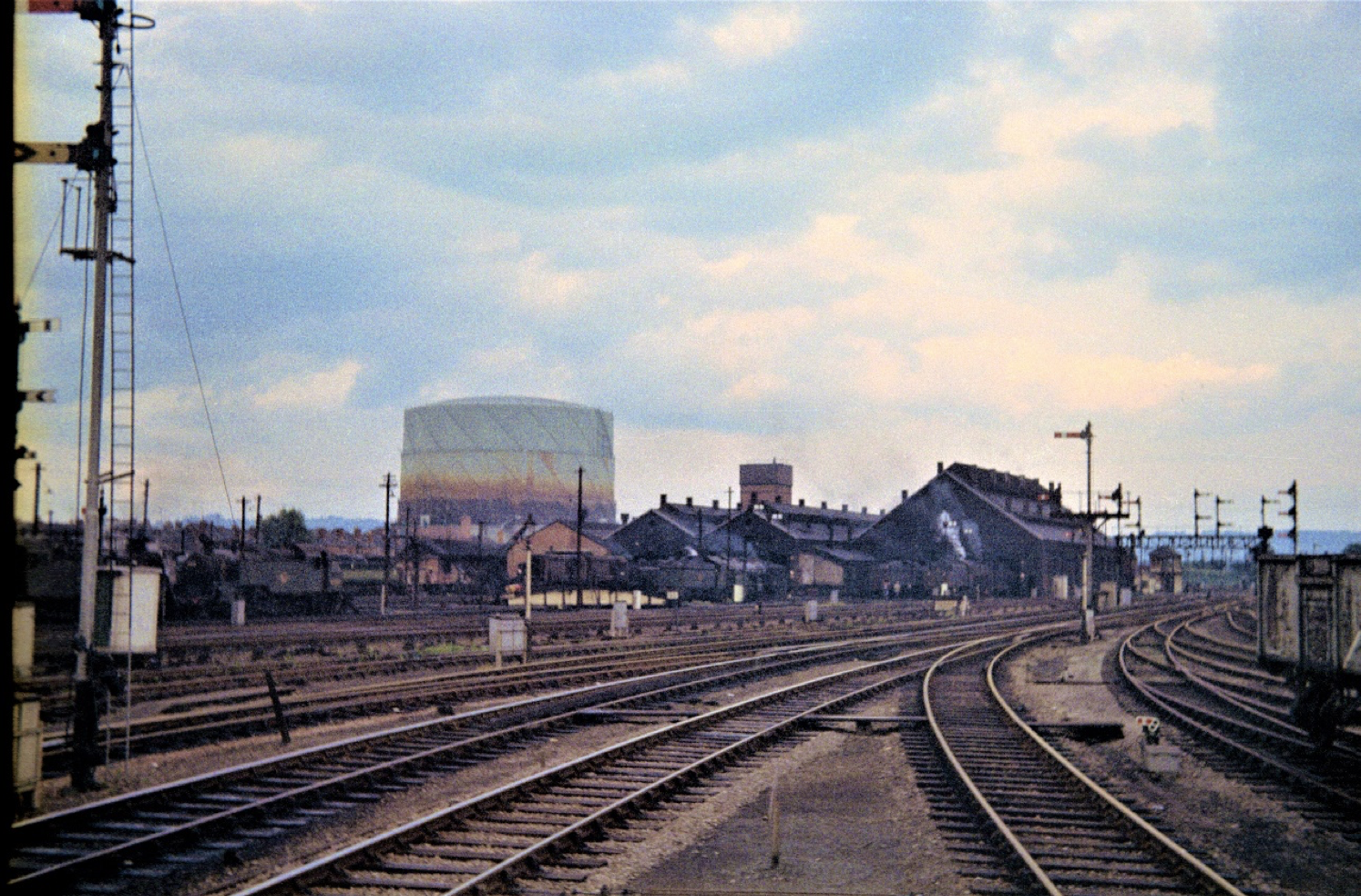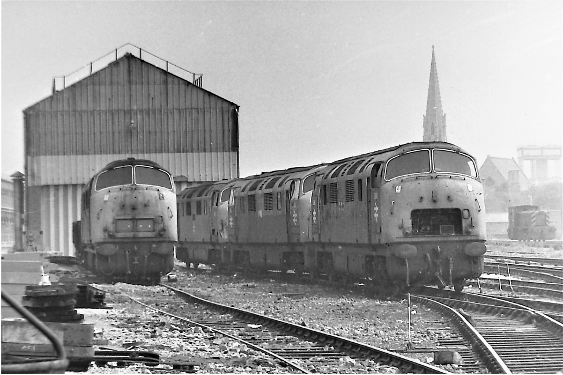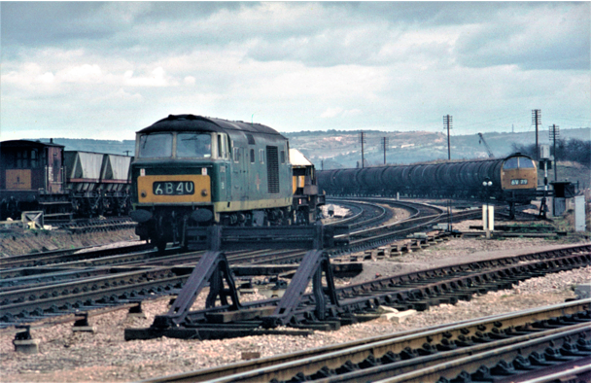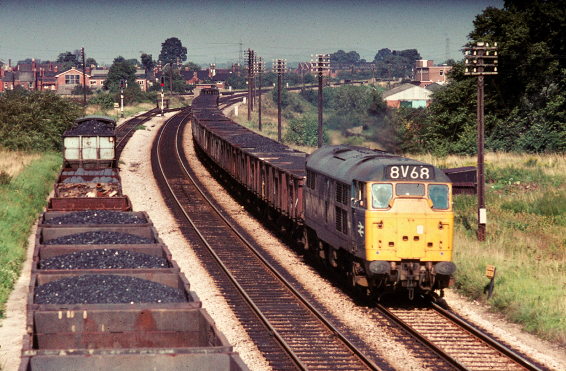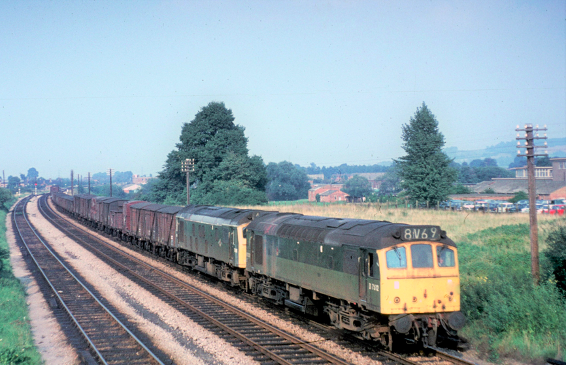Gloucester from 1967
Other Diesel Developments
Other motive power changes included the transfer of ‘Peaks’ from MR to WR (82A) in April 1969. However, by 1970 most Bristol – Birmingham workings were in the hands of Brush ‘Type 4s’, and consequently increasing numbers of ‘Peaks’ were being seen in South Wales on freight duties. With the confinement of hydraulic classes to core areas of the WR, other diesel-electric classes increasingly worked through to Gloucester on inter-regional freights. Sulzer ‘Type 2s’ were becoming increasingly common on freight from north by 1970, and eventually pairs of English Electric ‘Type 1s’ (D8000, later Class 20) would appear on coal trains from the East Midlands. Brush ‘Type 2s’ (Class 31) were being transferred to WR by January 1969, and pairs of English Electric ‘Type 3s’ (Class 37) were also in use on the Albion – Waterston oil tanker trains by February 1970.
‘Warships’ had started to receive maroon livery from autumn 1965, but this didn’t last long, before rail blue was introduced. By August 1968 No. D838 was the last one left in maroon livery. From April 1967, with the withdrawal of direct express services from Birmingham Snow Hill, Warships worked Paddington – New Street services until replaced by ‘Brush 4s’ at the start of 1968. In May of that year, ‘Warships’ were re-introduced to the West of England main line working in pairs on speeded up schedules, replacing ‘Westerns’. ‘Warships’ also found use on Worcester / Hereford trains until 1971. However, the class prototypes, Nos. D800-2 were withdrawn as early as September 1968. On a visit to Swindon Works on 29 July 1971, in the vicinity of the Weighbridge House, several ‘Warships’ were being stripped of parts, whilst a ‘Western’ was also waiting attention.
The first ‘Hymeks’ were working South Wales expresses in 1963, until teething problems with the more powerful ‘Westerns’ were sorted. The last ‘Hymek’ was delivered in 1964 and replaced steam on the Worcester line from May in that year. They proved to be versatile machines performing a variety of roles and were still in use on Cardiff – Portsmouth trains in Autumn 1971, having replaced Inter-City DMUs in May 1968. I remember around 1970 having a very quick run home behind a ‘Hymek’, which unusually was at the head of a cross-country train south from Birmingham New Street, then normally the preserve of ‘Peaks’ or ‘Class 47s’. With the momentum of the Lickey bank, speed was sustained at around 90 mph all the way from Bromsgrove to Cheltenham.
Although successful, being non-standard, the first members of the class, Nos. D7006/81 were withdrawn in September 1971. By January 1973, only 21 were left, and a Farewell tour was organised on 22 September 1973 with Nos. D7001/28. Despite this, the last four (Nos. D7011/7/8/22), were not withdrawn until March 1975.
The first ‘Westerns’ had been released from Swindon works in Spring 1962 and were working Wolverhampton /Birkenhead expresses by May, displacing Kings. Locos from No. D1035 onwards were built at Crewe, the first being completed in July 1962. Construction was slow as the Voith transmissions were provided under licence by North British, who were becoming insolvent. They were working South Wales expresses by late 1963, Cheltenham trains by May 1965 and Plymouth trains by August 1966. However, their tenure on the Birmingham line was short, as with the transfer of that line to LM control, they were largely replaced by ‘Brush 4s’ in late 1962.
Although some were fitted with air brakes, ‘Westerns’ were not equipped with electric train heating, and so could not be used on the latest Mk 2D stock being introduced onto South Wales and West of England trains. Air-braked stock had been introduced onto South Wales services from May 1968 and ETH stock in 1972 with ‘Brush 4s’ taking over most duties. As a result, the ‘Westerns’ were soon demoted to freight workings until their withdrawal. By October 1971, ‘Westerns’ were concentrated at Laira, where they remained, even after Swindon works ceased overhauling locomotives in 1973. Their swansong occurring in that year with their use on passenger services from Paddington to New Street via Oxford. By 1976 many were in store, and the last passenger ‘special’ ran on 26 February 1977.
Now released from express passenger duties in South Wales, ‘Western’ No. D1003 Western Pioneer waits in Barnwood sidings at the head of 6V79 empty tanks from Rowley Regis to Llandarcy, whilst ‘Hymek’ No. D7032 shunts a nuclear flask from Berkeley power station across Tramway Crossing in spring 1970.
Change was endemic in the 1970s as the number of loco-hauled expresses declined. ‘Class 50s’, based on the experimental DP2, had been introduced in 1968 and, on being made redundant by completion of the Euston – Glasgow electrification in 1974, were transferred to the Western Region. They were shedded at Laira, replacing the ‘Westerns’ from May 1975. However, in October 1976 a fleet of High-Speed Trains (HSTs) was introduced to the Paddington to Bristol and Swansea lines, bringing regular 125 mph running to the Western Region. West of England services were converted to HST running in 1979 and performed reliably for 40 years until their recent (2019) demise. The ‘Class 50s’ continued to find work on Waterloo to Exeter and Paddington to Gloucester and Worcester services into the 1980s.
This is not to say other diesel loco development was ignored. In January 1968 HS4000 was demonstrated on BR and used on coal freight services in the East Midlands, but none were ordered, and the prototype was taken out of BR use in March 1971. On the ECML, mark II air-conditioned stock was introduced from 1971, with ‘Deltic’ haulage on the most prestigious trains. They were replaced in the late 1970s by a second batch of HSTs that would speed up services in a similar way to those already introduced on the WR. Finally, electrification came in 1990 with the introduction of ‘Class 91’ electrics and mark IV rolling stock, capable of 140 mph running, although not called upon in practice.
DMUs started to receive ‘corporate blue’ livery in 1966. Heritage units continued to provide the mainstay for local services to Bristol, Swindon, Worcester and Cardiff, although units other than the Swindon-built ‘Cross Country’ versions became common with Metro-Cammell Class ‘101s’ working in the early 1980s transferred from the LM region. By 1987 Class ‘108’ and Class ‘117’ units were used on these workings until October 1988 when the first ‘150’ Class ‘Sprinters’ were introduced to Swindon – Cheltenham services.
